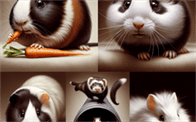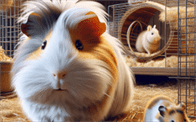Popular Small Mammal Pet Breeds You Can Own
Introduction
Did you know that small mammals are among the fastest-growing pet choices in households today? In recent years, many families have been opting for small mammal pet breeds over traditional pets like dogs and cats. According to the American Pet Products Association, small mammals like guinea pigs, hamsters, and rabbits are now owned by millions of families across the United States. This trend reflects a shift in pet ownership preferences, with more people recognizing the unique joys and benefits these pets bring.
The appeal of small mammal pet breeds lies in their low maintenance requirements, compact size, and the sheer joy they can add to our lives. Unlike larger pets that require extensive space and time commitments, small mammals can thrive in smaller environments, making them ideal for apartment dwellers and busy families. They are often less expensive to care for, and many of them are social creatures that thrive on interaction, providing companionship without the demanding nature of larger pets.
In this article, we’ll provide an overview of various small mammal pet breeds available for adoption, highlighting their unique characteristics, care requirements, and benefits. Whether you’re considering adding a furry friend to your family or simply curious about these delightful creatures, you’ll find invaluable information here.
For essential pet care tips, be sure to check our care tips for small mammal pets every owner should know. Let’s dive into the fascinating world of small mammals!
What are Small Mammal Pet Breeds?
Definition
Small mammal pet breeds refer to a variety of domesticated small mammals that are kept as pets. These breeds typically include animals like hamsters, guinea pigs, rabbits, ferrets, and gerbils. They are characterized by their small size, which makes them suitable for indoor living. These pets generally require less space compared to dogs or cats, allowing them to fit well into smaller homes or apartments.
Historical Context
The journey of small mammals as household pets began centuries ago. While dogs and cats have long been known as companions, small mammals gained popularity in the 20th century. Hamsters were first brought to the United States in the 1930s, and since then, their popularity has soared. Guinea pigs, originally domesticated by the Incas, have been cherished in homes for their friendly nature and social behaviors. Over the years, more breeds have emerged, each with unique traits and charm.
The Importance of Small Mammal Pet Breeds
The rise in pet ownership has seen a remarkable trend towards adopting small mammals. Many people are drawn to these animals for several reasons:
- Low Maintenance: They generally require less care than larger pets.
- Affordability: Their initial cost and ongoing expenses are usually lower.
- Space Efficiency: They don’t need large areas to roam.
- Companionship: Despite their size, many small mammals are interactive and affectionate.
Small Mammal Pet Breeds in the Context of the Pet Industry
The popularity of small mammal pet breeds has significantly impacted the pet industry. Pet stores and breeders have responded by increasing their offerings, leading to a wider variety of small mammals available for adoption. Many organizations also promote the benefits of adopting these pets, further driving their popularity.
Key Players or Contributors
Various organizations and breeders have played significant roles in promoting the adoption and care of small mammal pet breeds. The American Rabbit Breeders Association and the National Hamster Council, for example, provide resources for potential pet owners, ensuring they have the knowledge needed to care for their pets properly.
For more insights on selecting the right type of pet, refer to our guide to choosing the right pet breed.

How Do Small Mammal Pet Breeds Work?
The Mechanics of Small Mammal Pet Breeds
Caring for small mammal pet breeds involves understanding their specific needs and behaviors. Each breed has unique requirements that are crucial for their health and happiness.
- Habitat: A suitable habitat is essential. For example, hamsters need a cage with ample space to run and explore, while rabbits thrive in larger enclosures that allow them to hop freely.
- Diet: Each breed has specific dietary needs. Guinea pigs require a diet rich in vitamin C, while rabbits need hay as their primary food source.
- Social Interaction: Many small mammals are social creatures. For instance, guinea pigs thrive in pairs or groups, while hamsters are typically solitary but still require interaction with their owners.
Technological Foundations of Small Mammal Pet Breeds
Modern technology has also enhanced the way we care for small mammal pet breeds. Innovations in habitat design and care products make it easier for owners to provide the best possible environment for their pets. Here are some examples:
- Automated Feeders: These devices ensure that pets receive their meals at regular intervals, especially useful for busy owners.
- Smart Cages: Some cages now come with built-in monitoring systems that track the health and activity levels of pets, allowing owners to make informed decisions about care.
Real-World Applications of Small Mammal Pet Breeds
The charm of small mammals extends beyond just being pets. They have found roles in various real-world applications, including educational programs in schools and therapeutic settings. For instance, therapy animals often include small mammals because of their gentle nature and ability to bring comfort to individuals in need.
Additionally, small mammals can be excellent teaching tools for children learning about responsibility and empathy. By caring for these pets, kids can develop a sense of duty and compassion towards animals.
Benefits of Owning Small Mammal Pet Breeds
Companionship and Emotional Support
One of the most significant benefits of owning small mammal pet breeds is the companionship they provide. Many owners find joy in their pets’ quirky behaviors and personalities. Interaction with pets can lead to improved mental health, reducing feelings of loneliness and anxiety.
Low Maintenance Requirements
Compared to larger pets, small mammals are often easier to care for. They typically require less grooming, fewer exercise needs, and can often be left alone for longer periods without causing distress. This makes them ideal for busy individuals or families.
Educational Opportunities
Owning a small mammal can also serve as an educational experience. Children can learn about animal care, responsibility, and empathy through their interactions with their pets. This hands-on experience can foster a lifelong love for animals.
Space Efficiency
Small mammals are perfect for those living in apartments or smaller homes. Their compact size means they can live comfortably in cages or designated areas without requiring large backyards or extensive space.
Variety and Diversity
The world of small mammal pet breeds is rich with diversity. From the playful antics of ferrets to the gentle nature of rabbits, there’s a small mammal for every personality. This variety allows prospective pet owners to choose a breed that best fits their lifestyle and preferences.
For a closer look at specific breeds, check out our article on the most popular small mammal pets to own.
Popular Small Mammal Pet Breeds
Guinea Pigs
Guinea pigs are one of the most beloved small mammals. Known for their docile nature and social behavior, they make excellent pets for families. They thrive in pairs and require a spacious cage filled with bedding, hay, and fresh vegetables.
Hamsters
Hamsters are often the first pet choice for children. They are relatively low-maintenance and come in various breeds, including Syrian and dwarf hamsters. These nocturnal creatures enjoy running on wheels and exploring tunnels, making them entertaining to watch.
Rabbits
Rabbits have become increasingly popular as household pets. They are social animals that enjoy interaction with their owners. Providing a safe space for them to hop around is essential for their well-being. Rabbits can also be litter trained, making them easier to care for indoors.
Ferrets
Ferrets are playful and curious creatures that love to explore. They require social interaction and can be trained to perform tricks. Their playful nature makes them a joy to have around, but they do require more care than some other small mammals.
Gerbils
Gerbils are small, active rodents that are easy to care for. They are known for their burrowing habits and can be kept in pairs or small groups. Gerbils are generally friendly and can be a great choice for first-time pet owners.
Chinchillas
Chinchillas are unique pets known for their soft fur and playful demeanor. They require specific care, including dust baths for their fur and a cool environment to prevent overheating. Chinchillas can be quite affectionate and bond closely with their owners.
Hedgehogs
Hedgehogs have gained popularity as exotic pets. They are nocturnal and have unique personalities. Owning a hedgehog requires understanding their specific needs, including proper habitat setup and diet.
For tips on caring for specific small mammals, explore our comprehensive guides like guinea pig care: a complete guide and hamster pet care: a beginner’s guide.
Conclusion
In conclusion, small mammal pet breeds offer a delightful alternative to traditional pets. Their variety, low maintenance needs, and unique personalities make them perfect companions for
Resource Links:
- theroseandthethistle.com: … They were very expensive and were usually only owned by nobility or knights who could afford them. Dogs. Dogs were another popular animal among …
- reddit.com: … I have experience with mice, rats, hamsters and rabbits and my sister has gerbils and guinea pigs so I will talk to those. Mice are stinky but …
- quora.com: … Sugar Gliders. They are fairly easy to breed if you take care of them. There are very few breeders in the USA, so they sell for decent money …




0 Comments